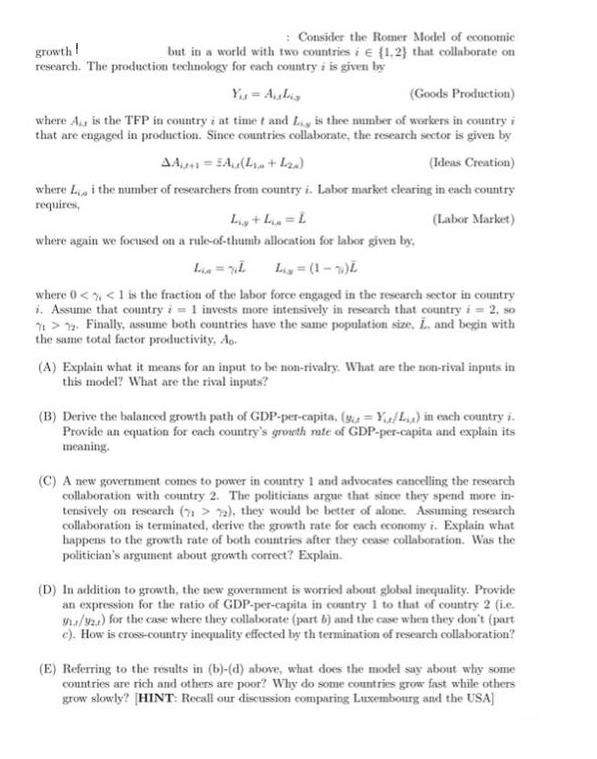Answered step by step
Verified Expert Solution
Question
1 Approved Answer
Consider the Romer Model of economic growth! but in a world with two countries i E (1.2) that collaborate on research. The production technology

Consider the Romer Model of economic growth! but in a world with two countries i E (1.2) that collaborate on research. The production technology for each country i is given by (Goods Production) where A, is the TFP in country i at time t and L is thee number of workers in country i that are engaged in production. Since countries collaborate, the research sector is given by AA = Au(+ [2x) (Ideas Creation) where L i the number of researchers from country i. Labor market clearing in each country requires, (Labor Market) Lig+L = L where again we focused on a rule-of-thumb allocation for labor given by, L = Lig=(1-1) where 0 < < 1 is the fraction of the labor force engaged in the research sector in country i. Assume that country i = 1 invests more intensively in research that country i = 2, so 7>72. Finally, assume both countries have the same population size. L. and begin with the same total factor productivity. A (A) Explain what it means for an input to be non-rivalry. What are the non-rival inputs in this model? What are the rival inputs? (B) Derive the balanced growth path of GDP-per-capita, (Y/L) in each country i. Provide an equation for each country's growth rate of GDP-per-capita and explain its meaning. (C) A new government comes to power in country 1 and advocates cancelling the research collaboration with country 2. The politicians argue that since they spend more in- tensively on research (7>72), they would be better of alone. Assuming research collaboration is terminated, derive the growth rate for each economy i. Explain what happens to the growth rate of both countries after they cease collaboration. Was the politician's argument about growth correct? Explain. (D) In addition to growth, the new government is worried about global inequality. Provide an expression for the ratio of GDP-per-capita in country 1 to that of country 2 (i.c. 9/92) for the case where they collaborate (part b) and the case when they don't (part c). How is cross-country inequality effected by th termination of research collaboration? (E) Referring to the results in (b)-(d) above, what does the model say about why some countries are rich and others are poor? Why do some countries grow fast while others grow slowly? [HINT: Recall our discussion comparing Luxembourg and the USA]
Step by Step Solution
★★★★★
3.54 Rating (157 Votes )
There are 3 Steps involved in it
Step: 1
A In this model nonrival inputs are those that can be used by multiple countries without diminishing the availability of the input for others In this ...
Get Instant Access to Expert-Tailored Solutions
See step-by-step solutions with expert insights and AI powered tools for academic success
Step: 2

Step: 3

Ace Your Homework with AI
Get the answers you need in no time with our AI-driven, step-by-step assistance
Get Started


